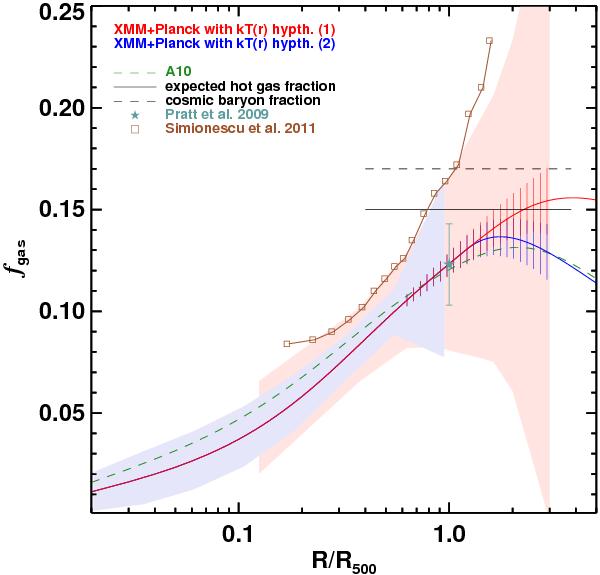Fig. 7

Gas mass fraction profile derived from the combined Planck and XMM-Newton pressure profile, assuming for the temperature profile: (H1) the average best fit model across the sample from X-ray spectroscopy (red line and striped area); or (H2) the same but extrapolating beyond R500 to a constant value equal to the average temperature measured in the last radial bin across the sample (blue line and striped area). The green dashed curve marks the expected gas fraction profile assuming the A10 pressure profile and kT(r) as in hypothesis (1). The star gives fgas(r = R500) for REXCESS clusters with M500 > 5 × 1014 M⊙ (Pratt et al. 2009). In maroon we reproduce the gas mass fraction profile derived from Suzaku measurements for the Perseus cluster (Simionescu et al. 2011). The solid and dashed black lines mark the cosmic baryon fraction expected from CMB measurements (Komatsu et al. 2011) and the expected gas fraction, assuming that 12% of baryons are in stars, respectively. The shaded blue and red areas translate the dispersion in the pressure profile across the ESZ–XMM sample as shown on Fig. 4 in our original paper, assuming hypothesis (H1) for kT(r). See Sect. 7.3 in Planck Collaboration (2013)
Current usage metrics show cumulative count of Article Views (full-text article views including HTML views, PDF and ePub downloads, according to the available data) and Abstracts Views on Vision4Press platform.
Data correspond to usage on the plateform after 2015. The current usage metrics is available 48-96 hours after online publication and is updated daily on week days.
Initial download of the metrics may take a while.


